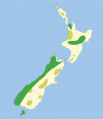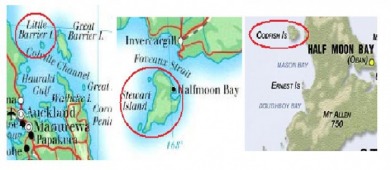Historical Range
Millions of years ago, there was an enormous abundance of kakapos living on all New Zealand islands. Many of the fossils discovered tell of many years of living without predators and its adaptations from a small, light, flying bird to plump, flightless, excellent hiker. Without predators, the kakapo population boomed enormously out of control.
When the Europeans settled in the 1840's the picture below shows the amount of kakapo left living in there original habitat; which was all of New Zealand.
The 1840's was the start of hunting for kakapo as food, clothing, ear ornaments and much more. Many of the kakapo started to decline because of their lack of defense mechanisms. By the 1880's, when more Europeans settled in the area, what happened was habitat fragmentation. So much land was being used for farming and cities and towns that the kakapo were being constantly pushed into smaller and smaller areas. This made it easier for hunters to catch them. Also owing to the faact that the kakapo also had a strong sweet odour to them, and that they had the tendency to freeze when found and were curious; all these factors added up to the fast and easy hunting if the kakapo.
During the 1860s, many museums and zoos sought them out to add to their collections but many of the kakapos held captive, died within months. In the 1870s, many European hunters understood and realized that they were going out but instead of trying to conserve the species, many hunters were concerned about catching the last few before they all went out. So when it was the 1890s, it was said that possibly the last kakapo was hunted down by a Maori hunter.
When the Europeans settled in the 1840's the picture below shows the amount of kakapo left living in there original habitat; which was all of New Zealand.
The 1840's was the start of hunting for kakapo as food, clothing, ear ornaments and much more. Many of the kakapo started to decline because of their lack of defense mechanisms. By the 1880's, when more Europeans settled in the area, what happened was habitat fragmentation. So much land was being used for farming and cities and towns that the kakapo were being constantly pushed into smaller and smaller areas. This made it easier for hunters to catch them. Also owing to the faact that the kakapo also had a strong sweet odour to them, and that they had the tendency to freeze when found and were curious; all these factors added up to the fast and easy hunting if the kakapo.
During the 1860s, many museums and zoos sought them out to add to their collections but many of the kakapos held captive, died within months. In the 1870s, many European hunters understood and realized that they were going out but instead of trying to conserve the species, many hunters were concerned about catching the last few before they all went out. So when it was the 1890s, it was said that possibly the last kakapo was hunted down by a Maori hunter.
Current Range
Now, the kakapo can only be found in certain parts of New Zealand where they are protected from their predators such as stoats, rats and dogs. These islands are conservation centers for them and it is where there are no human inhabitants except for the scientists and volunteer helpers. They live on three different islands: Little Barrier Island, Stewart Island and Codfish Island. Codfish Island is a small piece of land off the coast of Stewart Island. Little Barier Island is much up north in the Northern part of New Zealand. These three island all have similar characteristics which make it easier for kakapo to adapt to it.
Little Barrier Island is a volcanic island with steep slopes and deep ravines that are fitting for a climbing bird such as the kakapo. Codfish Island is specifically preserved as a predator free island with bird sanctuary especially for the kakapo and the kiwi. Stewart Island however, has many beaches and shores which scientists have said was caused by the fall of a meteorite into the Tasman Sea.
Many of these places still have forested area for the kakapo to live in and because of all these differences, it will be good for kakapos to adapt to the different abiotic factors of their environment.
Little Barrier Island is a volcanic island with steep slopes and deep ravines that are fitting for a climbing bird such as the kakapo. Codfish Island is specifically preserved as a predator free island with bird sanctuary especially for the kakapo and the kiwi. Stewart Island however, has many beaches and shores which scientists have said was caused by the fall of a meteorite into the Tasman Sea.
Many of these places still have forested area for the kakapo to live in and because of all these differences, it will be good for kakapos to adapt to the different abiotic factors of their environment.


